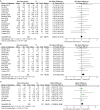Effects of Intermittent Fasting in Human Compared to a Non-intervention Diet and Caloric Restriction: A Meta-Analysis of Randomized Controlled Trials
- PMID: 35586738
- PMCID: PMC9108547
- DOI: 10.3389/fnut.2022.871682
Effects of Intermittent Fasting in Human Compared to a Non-intervention Diet and Caloric Restriction: A Meta-Analysis of Randomized Controlled Trials
Abstract
Background: The popularity of applying intermittent fasting (IF) has increased as more and more people are trying to avoid or alleviate obesity and metabolic disease. This study aimed to systematically explore the effects of various IF in humans.
Methods: The randomized controlled trials (RCTs) related to IF vs. non-intervention diet or caloric restriction (CR) were retrieved in PubMed, Web of Science, Cochrane Library database, and Embase. Extraction outcomes included, but were not limited to, weight, body mass index (BMI), waist circumference (WC), fasting glucose, and triglyceride (TG).
Results: This study includes 43 RCTs with 2,483 participants. The intervention time was at least 1 month, and the median intervention time was 3 months. Contrasting results between IF and non-intervention diet showed that participants had lower weight (weighted mean difference (WMD) = 1.10, 95% CI: 0.09-2.12, p = 0.03) and BMI after IF (WMD = 0.38, 95% CI: 0.08-0.68, p = 0.01). The WC of participants after IF decreased significantly compared with the non-intervention diet (WMD = 1.02, 95% CI: 0.06-1.99, p = 0.04). IF regulated fat mass (FM) more effectively than non-intervention diet (WMD = 0.74, 95% CI: 0.17-1.31, p = 0.01). The fat-free mass of people after IF was higher (WMD = -0.73, 95% CI: (-1.45)-(-0.02), p = 0.05). There was no difference in fasting blood glucose concentrations between participants in the after IF and non-intervention diet groups. The results of insulin concentrations and HOMA-IR, though, indicated that IF was significantly more beneficial than non-intervention diet (standard mean difference (SMD) = -0.21, 95% CI: 0.02-0.40, p = 0.03, and WMD = 0.35, 95% CI: 0.04-0.65, p = 0.03, respectively). Cholesterol and TG concentrations in participants after IF were also lower than that after a nonintervention diet (SMD = 0.22, 95% CI: 0.09-0.35, p = 0.001 and SMD = 0.13, 95% CI: 0.00-0.26, p = 0.05, respectively). IF outcomes did not differ from CR except for reduced WC.
Conclusion: Intermittent fasting was more beneficial in reducing body weight, WC, and FM without affecting lean mass compared to the non-intervention diet. IF also effectively improved insulin resistance and blood lipid conditions compared with non-intervention diets. However, IF showed less benefit over CR.
Keywords: caloric restriction; effect; intermittent fasting; meta-analysis; non-intervention diet.
Copyright © 2022 Gu, Fu, Hong, Ni, Yu and Lou.
Conflict of interest statement
The authors declare that the research was conducted in the absence of any commercial or financial relationships that could be construed as a potential conflict of interest.
Figures





Similar articles
-
Effects of Intermittent Energy Restriction Compared with Those of Continuous Energy Restriction on Body Composition and Cardiometabolic Risk Markers - A Systematic Review and Meta-Analysis of Randomized Controlled Trials in Adults.Adv Nutr. 2024 Jan;15(1):100130. doi: 10.1016/j.advnut.2023.10.003. Epub 2023 Oct 10. Adv Nutr. 2024. PMID: 37827491 Free PMC article.
-
Intermittent fasting and health outcomes: an umbrella review of systematic reviews and meta-analyses of randomised controlled trials.EClinicalMedicine. 2024 Mar 11;70:102519. doi: 10.1016/j.eclinm.2024.102519. eCollection 2024 Apr. EClinicalMedicine. 2024. PMID: 38500840 Free PMC article.
-
Effect of Epidemic Intermittent Fasting on Cardiometabolic Risk Factors: A Systematic Review and Meta-Analysis of Randomized Controlled Trials.Front Nutr. 2021 Oct 18;8:669325. doi: 10.3389/fnut.2021.669325. eCollection 2021. Front Nutr. 2021. PMID: 34733872 Free PMC article.
-
The effects of intermittent fasting on anthropometric indices, glycemic profile, chemotherapy-related toxicity, and subjective perception in gynecological and breast cancer patients: a systematic review and meta-analysis.BMC Cancer. 2025 Mar 7;25(1):419. doi: 10.1186/s12885-025-13806-9. BMC Cancer. 2025. PMID: 40055608 Free PMC article.
-
Effectiveness of an intermittent fasting diet versus regular diet on fat loss in overweight and obese middle-aged and elderly people without metabolic disease: a systematic review and meta-analysis of randomized controlled trials.J Nutr Health Aging. 2024 Mar;28(3):100165. doi: 10.1016/j.jnha.2024.100165. Epub 2024 Feb 2. J Nutr Health Aging. 2024. PMID: 38308923
Cited by
-
Efficacy of intermittent fasting on improving liver function in individuals with metabolic disorders: a systematic review and meta-analysis.Nutr Metab (Lond). 2025 Jan 6;22(1):1. doi: 10.1186/s12986-024-00885-x. Nutr Metab (Lond). 2025. PMID: 39762987 Free PMC article. Review.
-
Intermittent Fasting and Its Effects on Weight, Glycemia, Lipids, and Blood Pressure: A Narrative Review.Nutrients. 2023 Aug 21;15(16):3661. doi: 10.3390/nu15163661. Nutrients. 2023. PMID: 37630851 Free PMC article. Review.
-
Debunking the myths of intermittent fasting.Nat Rev Endocrinol. 2024 Sep;20(9):503-504. doi: 10.1038/s41574-024-01009-4. Nat Rev Endocrinol. 2024. PMID: 38898301 No abstract available.
-
Effects of Time-Restricted Feeding and Ramadan Fasting on Body Weight, Body Composition, Glucose Responses, and Insulin Resistance: A Systematic Review of Randomized Controlled Trials.Nutrients. 2022 Nov 11;14(22):4778. doi: 10.3390/nu14224778. Nutrients. 2022. PMID: 36432465 Free PMC article.
-
The impact of intermittent fasting on body composition and cardiometabolic outcomes in overweight and obese adults: a systematic review and meta-analysis of randomized controlled trials.Nutr J. 2025 Jul 30;24(1):120. doi: 10.1186/s12937-025-01178-6. Nutr J. 2025. PMID: 40731344 Free PMC article. Review.
References
-
- Ng M, Fleming T, Robinson M, Thomson B, Graetz N, Margono C, et al. . Global, regional, and national prevalence of overweight and obesity in children and adults during 1980-2013: a systematic analysis for the Global Burden of Disease Study 2013. Lancet (2014) 384:766–81. 10.1016/S0140-6736(14)60460-8 - DOI - PMC - PubMed
Publication types
LinkOut - more resources
Full Text Sources
Miscellaneous

